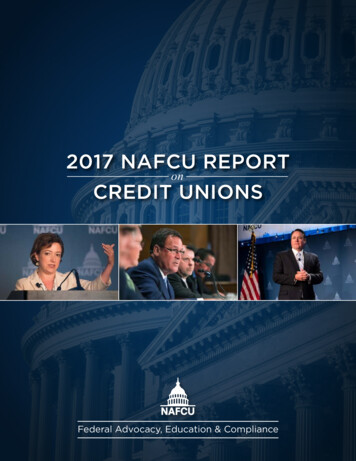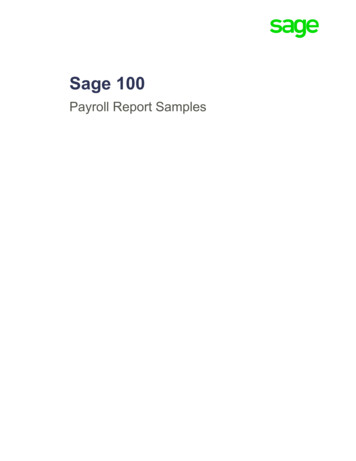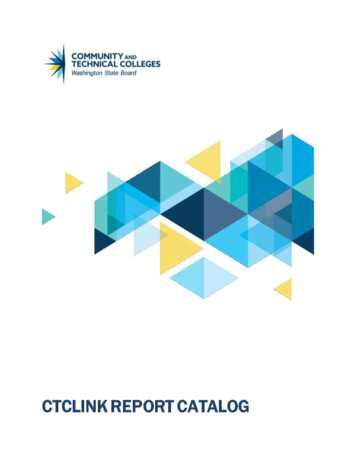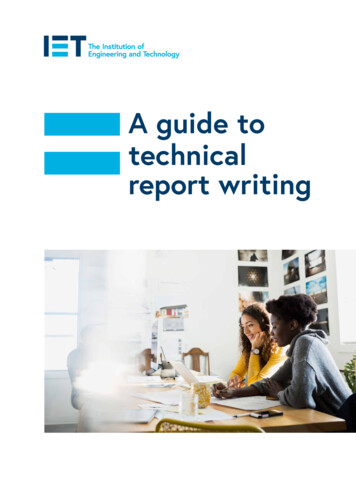
Transcription
2017 NAFCU REPORTonCREDIT UNIONSFederal Advocacy, Education & Compliance2017 NAFCU Report on Credit Unions 1
NAFCU REPORT ON CREDIT UNIONSNovember 2017Table of ContentsBACKGROUND5KEY FINDINGS7CREDIT UNION TRENDS8Role in the Economy8General Financial Conditions9Industry Consolidation11Lending Standards & Conditions12Liquidity13Secondary Mortgage Market14CREDIT UNION SERVICE TO MEMBERS AND USE OF FEDERAL RESERVE SERVICES15Electronic Financial Services15Federal Reserve Services16LEGISLATIVE ISSUES FACING CREDIT UNIONS19Preserving the Credit Union Tax Exemption19Regulatory Relief19Data and Cybersecurity20Interchange Fees21Member Business Lending22Capital Reform23Housing Finance Reform24REGULATORY ISSUES FACING CREDIT UNIONS25Federal Reserve25Consumer Financial Protection Bureau28National Credit Union Administration32Department of Defense35Federal Communications Commission35EMERGING CHALLENGES37An Evolving Financial Marketplace37An Unlevel Playing Field37Keeping Pace with Technological Change38Growing into the Future39This material was prepared for a meeting between the NAFCU Board of Directors and the Board of Governors of the Federal Reserve System
Board of Directors and President and CEO of NAFCURichard L. HarrisChairRegion V DirectorPresident/CEOCaltech EmployeesFederal Credit UnionLa Canada, CAAsset Size: 1.6BMembers: 32,146FOM: Multi-OccupationalJeanne KuceyVice ChairRegion III DirectorPresident/CEOJetStreamFederal Credit UnionMiami Lakes, FLAsset Size: 197MMembers: 21,704FOM: CommunityDebra sionFederal Credit UnionSan Diego, CAAsset Size: 3.3BMembers: 213,777FOM: CommunityThomas W. DeWittSecretaryRegion IV DirectorPresident/CEOState FarmFederal Credit UnionBloomington, ILAsset Size: 4.0BMembers: 130,598FOM: ServiceRobert L. FisherDirector-at-LargePresident/CEOGrow FinancialFederal Credit UnionTampa, FLAsset Size: 2.4BMembers: 199,046FOM: Multi-OccupationalGary GrinnellRegion I DirectorPresident/CEOCorningFederal Credit UnionCorning, NYAsset Size: 1.4BMembers: 103,797FOM: Multi-OccupationalJames A. KenyonDirector-at-LargePresident/CEOWhitefish Credit UnionWhitefish, MTAsset Size: 1.4BMembers: 54,899FOM: CommunityJan N. RocheDirector-at-LargePresident/CEOState DepartmentFederal Credit UnionAlexandria, VAAsset Size: 1.8BMembers: 77,814FOM: Multi-OccupationalCharles A. RutanDirector-at-LargePresident/CEOSouthwest AirlinesFederal Credit UnionDallas, TXAsset Size: 499MMembers: 50,627FOM: Multi-OccupationalBrian SchoolsRegion II DirectorPresident/CEOChartwayFederal Credit UnionVirginia Beach, VAAsset Size: 2.2BMembers: 182,422FOM: Multi-OccupationalDaniel WeickenandDirector-at-LargeCEOOrionFederal Credit UnionMemphis, TNAsset Size: 621MMembers: 62,261FOM: Multi-OccupationalB. Dan BergerPresident/CEONAFCUArlington, VAFOM is Field of Membership2 2017 NAFCU Report on Credit Unions
Board of Governors of the Federal Reserve SystemJanet Yellen, Chair of the Board of Governors. Her four-year term as Chair expires February3, 2018, and her 14-year term as member ends January 31, 2024. She began her termon February 3, 2014. Prior to her appointment, Dr. Yellen was Vice Chair of the Board ofGovernors, a president of the Federal Reserve Bank of San Francisco and a member of theFederal Open Market Committee. She is professor emeritus at the University of California atBerkeley and has been a faculty member since 1980. She was also chair of the President’sCouncil of Economic Advisers.Randal Quarles, Vice Chair for Supervision. He took office on Oct 13, 2017, to fill anunexpired term ending January 31, 2018. Prior to his appointment, Mr. Quarles was founderand managing director of the Cynosure Group. Before founding the Cynosure Group, he wasa partner at The Carlyle Group. Mr. Quarles served multiple positions in the Department ofTreasury, most recently as the Under Secretary of the Treasury for Domestic Finance. He alsoserved as the U.S. Executive Director of the International Monetary Fund, and was a partner atDavis, Polk & Wardwell.Jerome H. Powell, member of the Board of Governors. He took office on May 25, 2012, to fillan unexpired term ending January 31, 2014. He was reappointed and sworn in on June 16, 2014for a term ending January 31, 2028. Prior to his appointment, Mr. Powell was a visiting scholarwith the Bipartisan Policy Center, where he focused on federal and state fiscal issues. From1997 through 2005, he was a partner at The Carlyle Group. Mr. Powell also served as AssistantSecretary and as Undersecretary to the Treasury under President George H.W. Bush.Lael Brainard, member of the Board of Governors. She took office in June 16, 2014, to fillan unexpired term ending January 31, 2026. Prior to her appointment, Dr. Brainard servedas Undersecretary of the U.S. Department of Treasury and Counselor to the Secretary of theTreasury. Dr. Brainard also was previously the Vice President and Founding Director of theGlobal Economy and Development Program, and held the Bernard L. Schwartz Chair at theBrookings Institution. She also served in several staff positions in the Clinton Administrationand was a professor of Applied Economics at the Massachusetts Institute of Technology (MIT).2017 NAFCU Report on Credit Unions 3
AbbreviationsACHAutomated Clearing HouseAMLAnti-Money LaunderingANPRAdvanced Notice of Proposed RulemakingATMAutomated Teller MachineBSABank Secrecy ActCFPBConsumer Financial Protection BureauCLFCentral Liquidity FacilityCUMAACredit Union Membership Access ActCUSOCredit Union Service OrganizationDoDDepartment of DefenseDTIDebt-to-Income RatioEMVEuropay, MasterCard, and VisaFCCFederal Communications CommissionFCUFederal Credit UnionFHLBFederal Home Loan BankFICUFederally-Insured Credit UnionFISCUFederally-Insured State Chartered Credit UnionFOMField of MembershipFTEFull-Time EquivalentGSEGovernment-Sponsored EnterpriseHELOCHome Equity Line of CreditHMDAHome Mortgage Disclosure ActICBAThe Independent Community Bankers of AmericaMAPRMilitary Annual Percentage RateMBLMember Business LoanMLAMilitary Lending ActNACHANational Automated Clearinghouse AssociationNAFCUNational Association of Federally-Insured Credit UnionsNCUANational Credit Union AdministrationNCUSIFNational Credit Union Share Insurance FundNOLNormal Operating LevelPALPayday Alternative LoanPCAPrompt Corrective ActionPINPersonal Identification NumberQMQualified MortgageRBCRisk-Based CapitalROAReturn on AssetsTCPATelephone Consumer Protection ActTIPTrade, Industry, and ProfessionalUDAAPUnfair, Deceptive, or Abusive Acts and Practices4 2017 NAFCU Report on Credit Unions
BACKGROUNDThe National Association of Federally-Insured Credit Unions (NAFCU), founded in 1967, is the only national tradeassociation focusing exclusively on federal issues affecting the nation’s federally-insured credit unions (FICUs).NAFCU provides its members with representation, information, education, and assistance to meet the constantchallenges that cooperative financial institutions face in today’s economic environment. Membership in NAFCUis direct; there are no state or local leagues, chapters or affiliations standing between NAFCU members andNAFCU’s Arlington, Virginia headquarters.NAFCU MembershipNAFCU’s membership consists of the nation’s most innovative and dynamic FICUs, having various and diversemembership bases and operations. NAFCU proudly represents many smaller credit unions with relatively limitedoperations, as well as some of the largest and most sophisticated credit unions in the nation. NAFCU represents69 percent of total federal credit union (FCU) assets and 64 percent of all FCU member-owners. NAFCU’smembership also includes over 100 federally-insured state chartered credit unions (FISCUs).The Credit Union UniverseFederally Chartered Credit UnionsFederally chartered credit unions obtain their charters from, and are regulated by, the National Credit UnionAdministration (NCUA). Their member shares (deposits) are insured by the National Credit Union ShareInsurance Fund (NCUSIF), which is administered by the NCUA. As of June 2017, there were 3,568 FCUs, withassets of 698 billion and a membership base of approximately 58 million.Federally-Insured Credit UnionsAll FCUs are required to be insured by the NCUSIF. State chartered credit unions in some states are requiredto be federally insured, while others may elect to be insured by the NCUSIF. The term “federally-insured creditunions” refers to both federal and state chartered credit unions whose accounts are insured by the NCUSIF. Thus,FCUs and FISCUs are subsets of FICUs. As of June 2017, there were 5,696 FICUs, with assets of 1.35 trillion anda membership base of 110 million.Privately Insured Credit UnionsPrivate primary share insurance for FISCUs has been authorized in a number of states. Currently there areprivately insured credit unions operating in nine states (Alabama, California, Idaho, Illinois, Indiana, Maryland,Nevada, Ohio and Texas). There is only one private insurance company (American Share Insurance of Dublin,Ohio) offering credit unions primary share insurance and excess deposit insurance. Another private insurer(Massachusetts Share Insurance Corporation) offers only excess deposit insurance coverage.Corporate Credit UnionsCorporate credit unions are credit unions that serve other credit unions. Corporate credit unions provide servicessuch as investment products, advisory services, item processing and loans to their members. As of June 2017,there were 12 corporate credit unions with assets of 22 billion.2017 NAFCU Report on Credit Unions 5
NAFCU ResearchNAFCU devotes a great deal of institutional resources to keeping its finger on the pulse of its members’operations by surveying its membership regularly. In this report, we reference several research instruments:Economic & CU MonitorNAFCU’s Economic & CU Monitor is a monthly report based in part on survey responses by NAFCU membercredit unions on a special topic. The report includes a review of the survey responses, along with commentary oneconomic and industry trends.CU Industry Trends ReportNAFCU’s CU Industry Trends Report is a quarterly analysis of trends in the credit union industry, with keyfinancial ratios aggregated by region and asset class.NAFCU Report on Credit UnionsNAFCU’s Federal Reserve Meeting Survey is an annual assessment of NAFCU members covering topics wediscuss in the annual NAFCU Report on Credit Unions. Survey data for the current report was collected inAugust 2017.Economic Benefits of the Credit Union Tax Exemption to Consumers, Businesses, and theU.S. EconomyNAFCU commissioned a special study to examine what would happen to the U.S. economy if the presence ofcredit unions was reduced significantly as a result of eliminating the credit union federal tax exemption. The 2017study quantifies the benefits to all consumers – both credit union members and bank customers – of having astrong credit union presence in financial markets. The study shows that reducing the number of credit unionswould weaken competition for consumer financial services and lead to higher interest rates on consumer loansand lower interest rates on retail deposits. The study also estimates the broader economic impact of these lostconsumer benefits.Industry Performance MeasuresIndustry & Economic BriefingHas your CU received its final HMDAupdate from your vendor?By Curt Long, Chief Economist / Director of ResearchIndustry Outlook: Credit union growth trends showedfurther improvement in the second quarter. Membergrowth in particular is well above the historicalaverage. Loan growth has benefitted from increases inHELOCs as home values soar. Although share growthis strengthening, loan-to-share ratios continue to riseand are approaching pre-crisis levels. Rising creditcard delinquencies have been balanced by falling realestate loan delinquencies. NAFCU's Credit UnionSentiment Index declined in August as respondents'outlook on earnings and lending moderatedsomewhat, and the regulatory outlook fell from analready low level.70%Economic Conditions: A sizable upward revision tosecond-quarter GDP growth reflected strongconsumer spending and business investment.However, various measures of economic activity in thethird quarter have been muted. August job gains werebelow expectations, and downward revisions to priormonths added to the disappointment. The housingmarket continues to face supply constraints.Nevertheless, the Federal Reserve announced that itwould begin tapering its balance sheet in October andindicated that it expects another quarter-point rate hikein December.Based on the results of this month’s Economic & CUMonitor survey, credit unions are generally wellpositioned for the forthcoming HMDA changes,although implementation efforts are still ongoing.Asked about the level of confidence that their creditunion, or their third-party vendor, will successfullyimplement all the changes necessitated by the newrequirements by the upcoming effective date, 100percent of respondents indicated they are either "very"or "somewhat" confident that they will be ready for theJanuary 2018 effective date. Notwithstanding thisoverall confidence, only 10 percent of respondentshave already received final updates from their vendorsto implement the new data points (see chart),indicating that implementation work is still continuingdespite the deferred effective date. About one-third ofrespondents said they were experiencing somedifficulty or delay in receiving the new updates fromtheir vendor, perhaps indicating that bottlenecking atthe vendor level is slowing implementation efforts.Some credit unions are receiving wholesale updatesfrom their vendors (37.5 percent), but most anticipatefinal updates to be delivered in installments (50percent). While nearly 82 percent of respondents arenot anticipating any disruptions in the transition to thenew HMDA requirements, around 18 percent are stillunsure if disruptions will occur.Special Topic: HMDA ComplianceIn August, the CFPB issued a final rule amending a2015 rule that made several substantive changes toRegulation C's reporting requirements under theHome Mortgage Disclosure Act (HMDA). Most of thekey amendments included in the 2015 HMDA rule aredue to take effect starting on January 1, 2018. Otheramendments will become effective on January 1, 2019and January 1, 2020.The 2015 HMDA rule, among other things, expandedthe data credit unions are required to collect andreport under Regulation C. Some of the expandeddata collection and reporting is statutorily mandated bythe Dodd-Frank Act, which amended HMDA to requirecollection of certain new data points. In addition tothat expanded data collection, however, the 2015HMDA rule changed the scope of Regulation C’scoverage to include most closed-end loans, open-endlines of credit and reverse mortgages secured bydwellings. Notably, under this expansion, reporting isrequired on all home equity lines of credit (HELOCs).Economic & CU Monitor- October 2017Page 116%50%40%30%30%10%0%* four-quarter** SPLY sameused periodin theSharenumeratorlastgrowthyear(lhs)Member& sumMember growth (rhs)share growth60%60%20% Member and share growth are on the rise, while loan growth remains above 10 percent. Rising loan loss provision expenses and declining fee income are putting downward pressure on ROA. Stronger asset growth has resulted in a decline in the net worth ratio in 2017. Delinquencies and charge-offs remain muted, but the latter is on the Yes8.0%0.0%Loan growth &loan/share ratioLoan growth (lhs)Loan-to-share ratio (rhs)95%90%85%80%75%70%65%60%UnsureSource: NAFCU Economic & CU Monitor surveyRespondents estimated that, on average, around 19hours of training will be necessary to bring staff up tospeed on the new HMDA data points, and initialtraining costs are expected to average around 39,000 per credit union. Staff training for ethnicityand race data will be particularly important, as creditunions identify this data point as the most difficult tocollect and report accurately.ROA & components1.2%1.0%0.8%0.6%0.4%0.2%0.0%-0.2%ROA excluding stab exp (lhs)Loan loss provision (lhs)Fee Income ratio (rhs)Net Worth12%1.20%1.10%1.00%0.90%0.80%0.70%Net Interest Margin6%12%10%8%0%Asset YieldsLoan yieldInvestment yield10%Douglas Meade, Ph.D.Director of ResearchInterindustry Economic Research Fund, Inc.College Park, MD6%3%4%2%1%2%0%0%Loan loss reserves ratioMember BalancesDelinquency ratioNet charge-off ratioAverage loan balance ( )Average share balance ( ) 16,0001.5% 12,0001.0% 8,0000.5% 4,0000.0% 0take the survey at: www.nafcu.org/research/participate/NAFCU CU Industry Trends Report (NCUA Call Report data)6 2017 NAFCU Report on Credit UnionsRobert M. Feinberg, Ph.D.Professor of EconomicsAmerican UniversityWashington, DC8%4%Loan Performance4%8%5%2.0%16%11%9%0.60%0.50%Net interest margin (lhs)Interest income ratio (rhs)Cost of funds (rhs)January 2017Net worth ratio (lhs)Net worth growth (rhs)Economic Benefits of theCredit Union Tax Exemptionto Consumers, Businesses,and the U.S. d on behalf of the National Association of Federally-Insured Credit Unionswww.nafcu.org/research
KEY FINDINGSCredit union trends›› Overall industry growth is strong, despite the fact that not-for-profit credit unions are small, highly regulatedand typically operate with much smaller margins than their for-profit counterparts.›› Credit unions are healthy and well-capitalized, and the industry is continuing to strengthen following thefinancial crisis.›› Credit unions are good actors that did not cause the financial crisis; nevertheless, smaller credit unions inparticular continue to struggle under immense regulatory burden. Industry consolidation has accelerated inrecent years, with the number of credit unions declining at a pace of nearly one per day.Credit union service to members and use of Federal Reserve services›› Investing in technology is a priority for credit unions, as evidenced by the growth in the number ofinstitutions offering remote deposit capture, mobile payments, and other electronic services.›› Credit unions are expanding their internet banking and mobile banking offerings. Credit unions also plan toinvest heavily in mobile banking, online banking platforms and in ways to optimize customer developmentover the next three years.›› The Federal Reserve remains a critical source of transaction services for the industry.Legislative issues facing credit unions›› Credit unions provide over 16 billion annually in benefits to the economy, and preserving the credit uniontax exemption remains NAFCU’s top legislative priority.›› Several basic tenets of a healthy and appropriate regulatory environment are necessary for credit unions tothrive: a regulatory framework that allows credit unions to grow; tailored regulation and relief from growingregulatory burdens; a fair playing field; transparency and independent oversight; and an independent NCUAas the primary regulator for credit unions.›› Particularly in light of the massive Equifax data breach, credit unions face growing concerns over data andcybersecurity. Uniform national data security standards are now more important than ever.Regulatory issues facing credit unions›› Modernized field of membership rules, including a strong federal charter and the ability to serve underservedareas, are crucial to the future welfare of the credit union industry.›› Credit unions continue to labor under the immense cumulative regulatory burden in the post Dodd-Frankera. Compliance challenges are exacerbated by the CFPB’s seeming lack of understanding of the operationaldifficulties associated with implementing its complex rules.›› NAFCU continues to work to ensure that any new payments system will be cost-effective, operationallyeffective and scalable for credit unions of all sizes.Emerging challenges›› In the face o
Federal Credit Union Dallas, TX Asset Size: 499M Members: 50,627 FOM: Multi-Occupational Brian Schools Region II Director President/CEO Chartway Federal Credit Union Virginia Beach, VA Asset Size: 2.2B Members: 182,422 FOM: Multi-Occupational Daniel Weickenand Director-at-Large CEO Orion Federal










